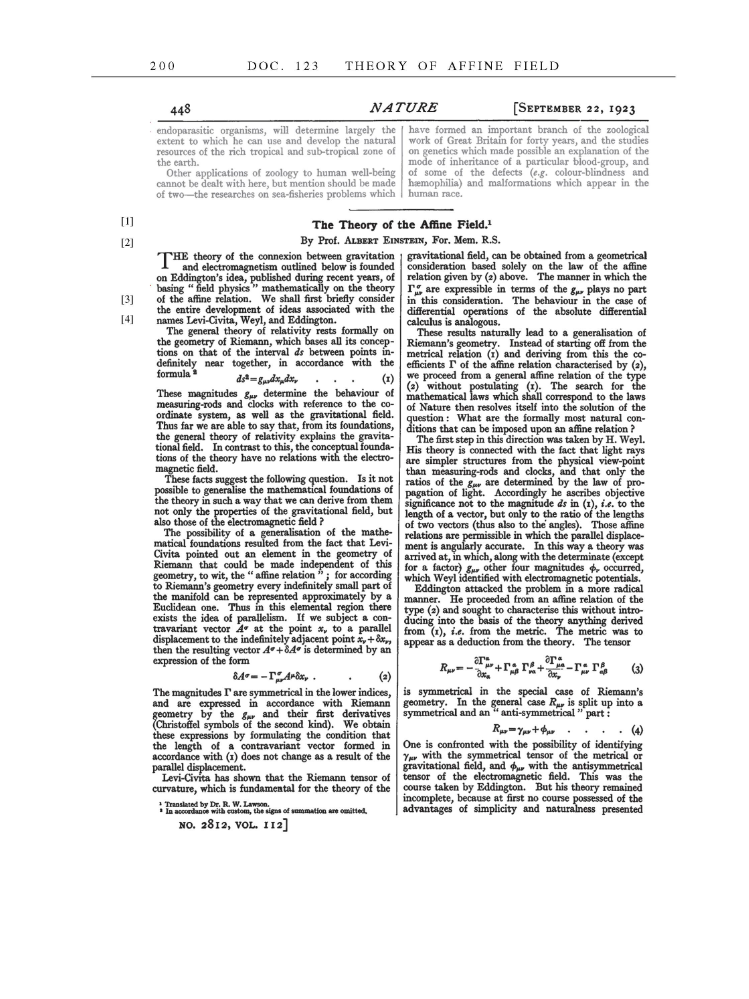200 DOC. 123 THEORY OF AFFINE FIELD 448 endoparasitic organisms, will determine largely the extent to which he can use and develop the natural resources of the rich tropical and sub-tropical zone of the earth. Other applications of zoology to human well-being cannot be dealt with here, but mention should be made of two-the researches on sea-fisheries problems which [SEPTEMBER 22, 1923] have formed an important branch of the zoological work of Great Britain for forty years, and the studies on genetics which made possible an explanation of the mode of inheritance of a particular blood-group, and of some of the defects (e.g. colour-blindness and haemophilia) and malformations which appear in the human race. NATURE [1] [2] [3] [4] The Theory of the Affine Field.1 By Prof. ALBERT EINSTEIN, For. Mem. R.S. THE theory of the connexion between gravitationgravitational and electromagnetism outlined below is foundedconsideration on Eddington’s idea, published during recent years, of basing “field physics” mathematically on the theory of the affine relation. We shall first briefly considerin the entire development of ideas associated with the names Levi-Civita, Weyl, and Eddington. The general theory of relativity rests formally on the geometry of Riemann, which bases all its concep- tions on that of the interval is between points in- definitely near together, in accordance with the formula2 is*=g^ix, ... (1) These magnitudes g^ determine the behaviour of measuring-rods and clocks with reference to the co- ordinate system, as well as the gravitational field. Thus far we are able to say that, from its foundations, the general theory of relativity explains the gravita- tional field. In contrast to this, the conceptual founda- tions of the theory have no relations with the electro- magnetic field. These facts suggest the following question. Is it not possible to generalise the mathematical foundations of the theory in such a way that we can derive from them not only the properties of the gravitational field, but also those of the electromagnetic field ? The possibility of a generalisation of the mathe- matical foundations resulted from the fact that Levi- Civita pointed out an element in the geometry of Riemann that could be made independent of this geometry, to wit, the “affine relation” for according to Riemann’s geometry every indefinitely small part of the manifold can be represented approximately by amanner. Euclidean one. Thus in this elemental region there exists the idea of parallelism. If we subject a con- travariant vector A" at the point xy to a parallel displacement to the indefinitely adjacent point *„+&»„, then the resulting vector A'’+8A” is determined by an expression of the form 8A*= -T’^Sxy . . (2) The magnitudes F are symmetrical in the lower indices, and are expressed in accordance with Riemann geometry by the ghv and their first derivatives (Christoffel symbols of the second kind). We obtain these expressions by formulating the condition that the length of a contravariant vector formed in accordance with (1) does not change as a result of thewith that the Riemann tensor of curvature, which is fundamental for the theory of the parallel displacement Levi-Civita has sh 1 Translated by Dr. R. W. Lawson. 2 In accordance with custom, the signs of summation are omitted. NO. 2812, VOL. 112] field, can be obtained from a geometrical based solely on the law of the affine relation given by (2) above. The manner in which the are expressible in terms of the ghy plays no part this consideration. The behaviour in the case of differential operations of the absolute differential calculus is analogous. These results naturally lead to a generalisation of Riemann’s geometry. Instead of starting off from the metrical relation (1) and deriving from this the co- efficients T of the affine relation characterised by (2), we proceed from a general affine relation of the type (2) without postulating (1). The search for the mathematical laws which shall correspond to the laws of Nature then resolves itself into the solution of the question : What are the formally most natural con- ditions that can be imposed upon an affine relation ? The first step in this direction was taken by H. Weyl. His theory is connected with the fact that light rays are simpler structures from the physical view-point than measuring-rods and clocks, and that only the ratios of the g^v are determined by the law of pro- pagation of light. Accordingly he ascribes objective significance not to the magnitude is in (1), i.e. to the length of a vector, but only to the ratio of the lengths of two vectors (thus also to the angles). Those affine relations are permissible in which the parallel displace- ment is angularly accurate. In this way a theory was arrived at, in which, along with the determinate (except for a factor) g^ other four magnitudes f,. occurred, which Weyl identified with electromagnetic potentials. Eddington attacked the problem in a more radical He proceeded from an affine relation of the type (2) and sought to characterise this without intro- ducing into the basis of the theory anything derived from (1), i.e. from the metric. The metric was to appear as a deduction from the theory. The tensor ôFa 9p « - 3*r+r¿ r^+isf-r¿ (3) is symmetrical in the special case of Riemann’s geometry. In the general case Rßy is split up into a symmetrical and an “ anti-symmetrical ” part : R »..=»+£,......(4) One is confronted with the possibility of identifying the symmetrical tensor of the metrical or gravitational field, and ƒ,,„ with the antisymmetrical tensor of the electromagnetic field. This was the course taken by Eddington. But his theory remained incomplete, because at first no course possessed of the advantages of simplicity and naturalness presented
